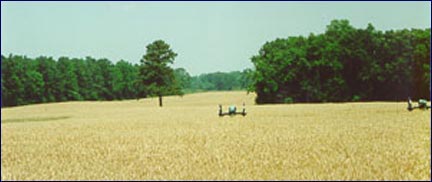Glendale/Malvern Hill Civil War Battlefield
30 June 1862/1 July 1862
Directions to Malvern Hill Battlefield: From Richmond take 64 East to 295 South (Exit
200) Go south on 295 to Exit 22A
(Rt. 5 East). Go 4.5 miles
to Rt. 156 North (Willis Church Road) and turn left. Go
1.2 miles to Malvern Hill Battlefield. The parking lot is
on the left.
General Description: This property is comprised of three parcels totaling 733.57 acres. 208 of the acres are located at the southern-most section of the Glendale Battlefield. The balance, the Malvern Hill parcels, include the Parsonage ruins, the are where Confederate forces formed up for the assault on Malvern Hill, and the attack routes themselves.
Civil War History: The Battles of Glendale, June 30, 1862, and Malvern Hill, July 1, 1862, were the final two actions of the famous Seven Days' Campaign. Following Union General George B. McClellan's laborious advance up the Peninsula in April/May 1862, and General Robert E. Lee's appointment to command of the Confederate army on June 1st, the two armies sat facing each other, waiting for reinforcements and the opportunity to make a move.
Taking advantage of McClellan's passivity, Lee took the initiative and on June 26, 1862 struck McClellan's exposed right flank first at Mechanicsville, then the next day at Gaines Mill. Once McClellan decided to change his base of supplies to Harrison's Landing on the James River, Lee saw the opportunity to destroy the Army of the Potomac as it retreated south.
After an unsuccessful attempt to defeat McClellan on June 29 at Savage's Station, Lee planned to cut off the Federal retreat route the next day at Glendale. Converging Confederate forces under James Longstreet, A.P. Hill and Benjamin Huger were to press the Federal forces from the west, while Thomas J. "Stonewall" Jackson was to overwhelm the Federal rearguard at White Oak Swamp to the north.
As had happened all week, Lee's plans went awry. Only Hill and Longstreet's division were sent into the fray, and although temporarily successful around the Glendale crossroads, Federal reinforcements from White Oak Swamp proved decisive in repulsing Confederate attacks. The fighting ended at dark, with casualties numbering some 3,700 Confederates and nearly 3,800 Federals.
During the night McClellan withdrew his forces to Malvern Hill. Disappointed that the Union army had escaped, Lee decided to hit McClellan one more time, on July 1, 1862.
In a series of uncoordinated assaults, typical of the Confederate efforts that entire week, John B. Magruder's, D.H. Hill's and Huger's divisions vainly attacked the massed Federal artillery and infantry positions on Malvern Hill. By the end of the day some 5,700 Confederate soldiers lay dead and wounded on the slopes, and General D.H. Hill was moved to say that, "It was not war, it was murder." Federal casualties numbered about 3,000.

That evening, McClellan continued his retreat to Harrison's Landing, where the army remained until mid-August 162, when it withdrew back down the Peninsula and returned to northern Virginia.
The Property: The Glendale property was the position of General Joseph B. Hooker's Federals during the battle. This area, called the "Slash," was heavily timbered this century and little resembles its 1862 appearance. Some fighting occurred here, although most took place further to the west and north.
The Malvern Hill parcels include the site of the Parsonage ruins, areas where Confederate units formed up for the attack, and the actual assault routes. Malvern Hill also has site interpretation and pull offs.
Instructions: Parking is available at the Glendale site, the Parsonage ruins, and an old dirt road at the lower reaches of Malvern Hill. Written permission is not required, but visitors should not disturb the farming operations at the sites.